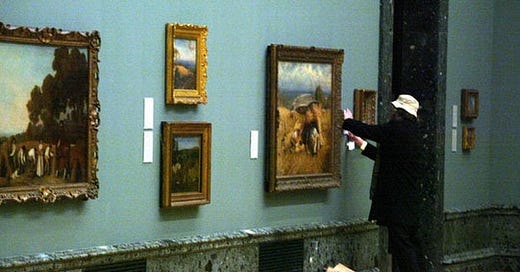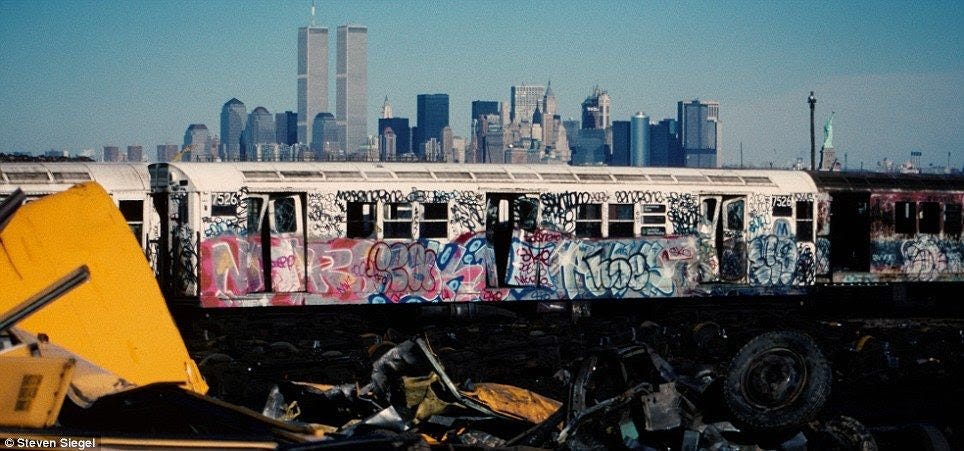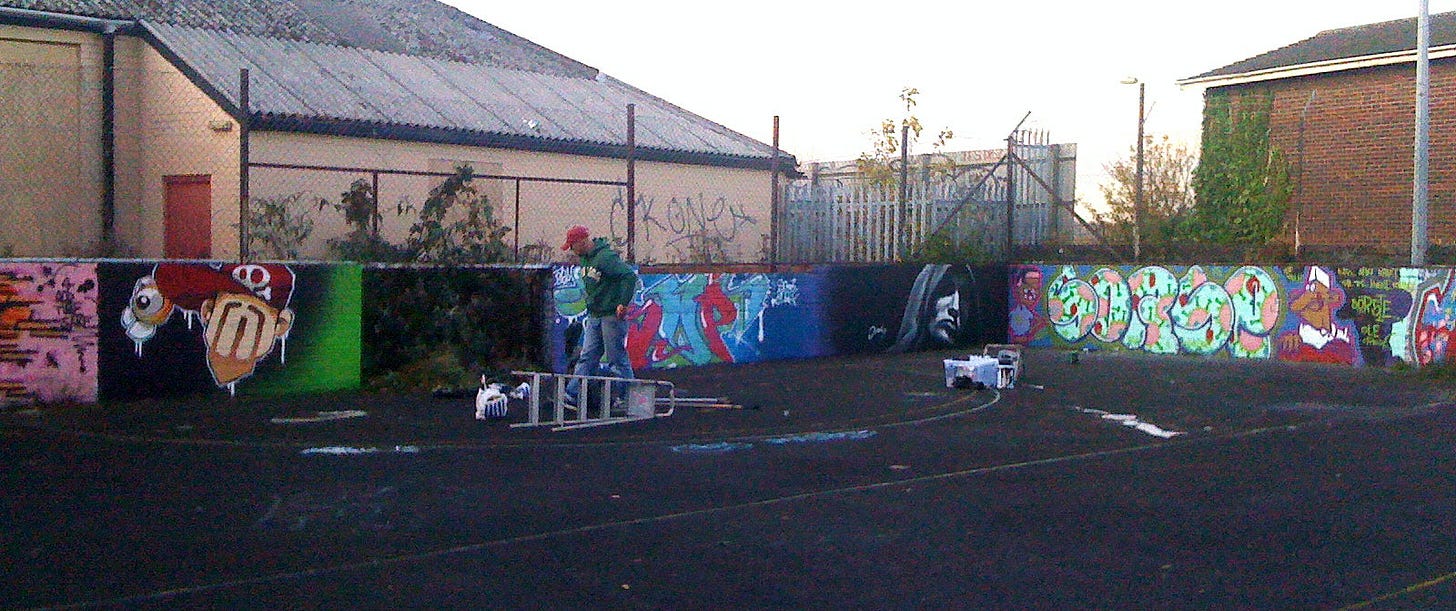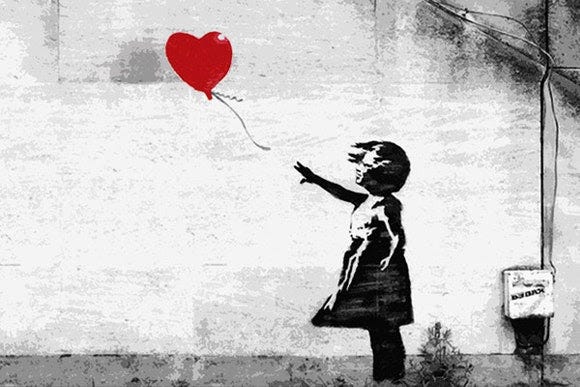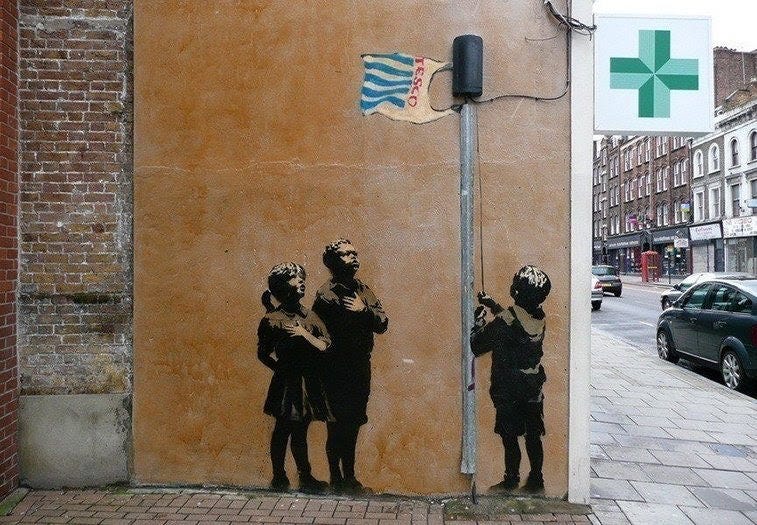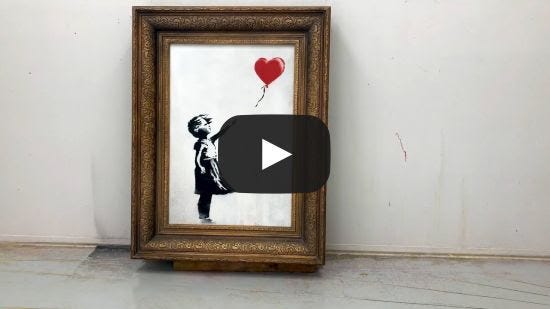Investing in Art: Banksy
Guest writer & art investor Ayo Shonibare shares some background into the elusive artist
A few weeks ago we dropped a publication called ‘Same Sh*t Different Asset Class’ where the topic of art investing emerged. Ayo Shonibare has been investing in collectible items such as luxury watches for some time now and in recent years blue-chip art. His favourite artist is Banksy, of which he owns a number of derived pieces. I’m pretty sure we’re all aware of the often viral antics displayed by Banksy but who is this guy in the first place? Ayo kindly agreed to give us the historic scoop on the Bristol-born street artist. Viral acts largely underpin the crazy valuations his works command, and people tend to invest large amounts in his works so who is he?
If you are considering investing in art at some point, this will be a great information primer to set the scene before diving into fundamental research and due diligence - the final paragraph is a must read!
Let's have a chat about BANKSY
Vandal or genius?
In the UK, 178,415 students took up “creative arts & design” related subjects in 2017 alone, according to HESA. Those planning on showcasing their art to the country, or potentially the globe understand competition is fierce. The conventional gameplan to fame and notoriety is; work hard for several years, somehow draw the attention and interest of international galleries and then agree on contractual terms. The artist’s role is to create, the gallery’s objective is to develop the artist, promote and ultimately sell the art, sounds reasonable? Well not for Banksy.
Banksy began a game of cat and mouse in 2003. The first gallery he made victim was the Tate Modern, placing his own private work onto the gallery’s wall, bypassing security. It is reported the gallery embarrassingly took down the piece and placed it in lost property, the news spread like wildfire. With no announcement of an arrest, Banksy was still on the loose, and in subsequent years he went on to place more of his pieces in museums such as: The Natural History Museum, the Louvre, and the Museum of Modern Art. Banksy had arrived.
Mysterious man (potentially Banksy or an associate) placing his work on gallery wall. Photo taken from Web Urbanist
Before many called him a vandal, Banksy grew up in a ‘normal’ household. A boy raised in Bristol who simply enjoyed graffiti. He reportedly achieved an underwhelming grade ‘E’ at school for art and did not attend art school. In his recent documentary, “Banksy and the Rise of Outlaw Art”, he claims, “Graffiti is one of the few tools you have if you have almost nothing. And even if you don't come up with a picture to cure world poverty you can make someone smile while they're having a piss.” It is clear Banksy was inspired by the radical graffiti movement which originated in the lower east side of Manhattan, New York. Originally, many ‘taggers’ would use markers and spell out their names on walls, the art form morphed into the use of vibrant colours, spray-painted on trains which traveled throughout the city. Many did graffiti at the time because they felt they were leaving their mark on the city.
Photo of a New York train in the 80s. Photo taken from Daily Mail
It is safe to say, those in New York pioneered the movement, but Banksy had his own ideas on how to take it forward. Banksy’s work combines graffiti, social activism, and stencil work all in one. As righteous as that sounds, there is still one problem. It is illegal. Banksy watched his city, as well as the country, suffer from increasing unemployment (over three million people) under Margaret Thatcher’s reign which ignited riots and an anti-authoritarian attitude among society.
John Nathan offered a platform for children and young adults to exert their concerns. Nathan ran the Barton Hill Youth Center, Barton Hill was infamously known for being an unsafe area in Bristol. Banksy describes the wall him and other friends graffitied on as “the most inspiring stretch of concrete in Bristol”, as Nathan allowed members of the youth center to freely spraypaint on the property.
Photo of man working on graffiti at Barton Hill Youth Center. Photo taken fromm Bristol Graffiti
Those who expressed their creative freedom sometimes took their skills outside of the youth center, this attracted the attention of locals. Over time, the metropolitan police became increasingly concerned about the amount of graffiti consuming Bristol and decided to take action. In the summer of 1989, the largest anti-graffiti operation took place (Operation Anderson), authorities raided and arrested 72 suspects. Nathan was also arrested and was threatened to co-operate or risk being charged with conspiracy as the police could not pin him to any of the actual spraypaintings on private property. Nathan remained silent and revealed no information. The police followed up on their threats and charged Nathan with conspiracy, a criminal record which stains his name but many artists still respect Nathan for staying loyal to the children and young adults who visited his youth center. The consequences of the raid were felt immediately, the majority of those who previously graffitied stopped in fear of prison sentences. Although, those who continued went underground, concealing their identities from the public.
Banksy is a great freehand artist but in light of the arrests, many argue Banksy implemented stenciling due to how easy it is to complete a piece of work. Legendary street artist Ben Eine said, “something that would normally take hours can take 5 minutes” when asked his opinion on stenciling. Other art critics rebuke the stencil technique as they see it as ‘cheating’. Banksy replied, “traditional graffiti artists have a lot of rules they like to stick to, but I didn’t become a graffiti artist to have other people tell me what to do.”
The street art scene in London grew and its mecca was Shoreditch, HQ was The Dragon Bar - elite street artists often congregated there and plotted to take on the city. Banksy’s work popped up everywhere, due to his consistent, noticeable and pulverising works, he interwove himself into the fabric of the emerging street art world. His ability to convey a strong message with simple imagery for all to understand, digest and question is magical. Arguably the best example is Girl With Balloon. The piece was created in 2002, but it is still as powerful as ever. Close to two decades after it was created and the world is still torn between, whether the girl has just lost her heart shaped balloon or is she centimeters away from catching it?
Girl With Balloon, Banksy. Photo taken from Guy Hepner
As time passed, the hype surrounding the mysterious man grew. Hosting shows and selling works at prices his agent at the time (Steve Lazarides) confessed were, “made up”. Members of the public including A-class celebrities attended wild exhibitions where they saw painted cows, elephants, pigs among other fascinating things.
Very Little Helps, Banksy. Photo taken from My Art Broker
As Banksy’s work became even more prolific, the works became progressively valuable. His works have been carved out of walls by individuals/groups who look to turn six-figure profits on original works. Due to the chaos, he and his team decided to incorporate a company; Pest Control - the organisation provides certificates to works and authenticates pieces bought in the secondary market either via auction or private transactions. In the past, works were sold for a couple of hundred pounds and hung using inexpensive frames, these same pieces may be worth hundreds of thousands today hence why an authorised body was established to legitimise it all.
In 2005, Banksy went to Palestine. International publications praised the artist yet again, he had taken on the largest wall in the world. Banksy said, “I don’t want to take sides but when you see entire suburban neighborhoods reduced to rubble, with no hope in the future, what you’re really looking at is a vast recruitment center for terrorists, and we should probably address this for all our sakes.”
Banksy’s work on the Israeli West Bank barrier. Photo taken from Scene Arabia
Just when we thought Banksy could not top his last exhibition, he defied the odds. In 2015, Dismaland was attended by 200,000 visitors in just over a month, the website crashed several times as six million users tried to purchase tickets - some argue the website crashing was not a server issue, it was another ironic joke Banksy was playing as the concept of the ‘amusement park’ was despair and boredom. Staff members were often rude, the technology on-site was intentionally faulty. Again, Banksy was unapologetically conveying a message, clearly playing on the fact his amusement park was intended to be the opposite of fun. Was Dismaland a massive metaphor for our lives, fake promises by capitalists fulfilling their marketing campaigns with products that miss the mark, and yet we are too blind to see?
Lastly, it is impossible not to mention the stunt Banksy pulled at Sotheby’s in 2018, after his most recognisable piece, Girl With Balloon sold for £1.04m. Allegedly, someone in the room activated the shredder built within the frame and the work was left half destroyed - some in the room screamed terrified. Due to the event, and it catching worldwide news, the piece doubled in value. The genius marketer had struck again.
“Shredding the Girl and Balloon - The Director’s half cut”. Video from YouTube
The search for Banksy’s true identity continues, forums are packed with theories and assumptions of who Banksy may be. Many believe it is Del Naja of pop band Massive Attack, some believe it is a team of people. Although, maybe, we are looking in all the wrong places. Banksy is one of the largest artists in the world at the moment, and he has successfully earned his spot at the top because we, the public hail him as our prophet. He communicates our political, economic, socio-cultural, and technological frustrations succinctly. He manages to always be there when we need him, he is our voice. The reason why Banky’s work resonates with us all, alongside why he is so hard to track is, he could be any of us. This is the fundamental conundrum behind Banksy.
Hope this serves as useful fuel if you do dive into investing in art :)
Catch you on the other side, peace! ✌🏾
Reminder: premium posts detailing a £20k portfolio journey will be dropping in addition to the standard weekly posts very soon! If you haven’t already, please indicate your interest here and thanks to those who have done so already! :)
Next week’s Publication: Deploying Some Fresh Cash (£1000)

